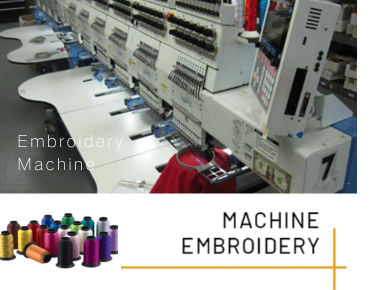AI Boost: The Future of Digitizing Embroidery
Embroidery, an ancient art form cherished for its intricacy and beauty, is undergoing a revolutionary transformation. The advent of Artificial Intelligence (AI) is breathing new life into the industry, blending tradition with cutting-edge technology. This confluence promises to not only enhance creativity but also streamline the entire embroidery process. If this post spurred your interest and you want to find out more about Embroidery Digitizing, please feel free to contact us.
The Intersection of AI and Embroidery: A Brief Overview
The fusion of AI and embroidery might seem unconventional at first glance. Yet, this amalgamation is opening new avenues for efficiency, precision, and creativity. As AI continues to evolve, it brings unprecedented capabilities to the embroidery industry, transforming how designs are conceptualized, digitized, and executed.
What is Embroidery Digitization?
From Hand-Stitching to Digital Stitching: A Quick History
Embroidery has long been synonymous with meticulous handcrafting. Over time, the process evolved from manual stitching to mechanized methods, culminating in today’s digital stitching. Embroidery digitization involves converting artwork into a digital file that embroidery machines can read, revolutionizing how intricate designs are brought to life.
Why Digitize Embroidery? Benefits and Challenges
Digitizing embroidery offers myriad benefits, such as enhanced design precision and scalability. However, it also presents challenges, including the need for specialized software and skills. The digitization process streamlines production while maintaining the artistic integrity of traditional methods.
The Role of AI in Modern Embroidery
AI is reshaping modern embroidery by automating processes, enhancing precision, and improving overall efficiency.
Automating the Design Process
How AI Transforms Artistic Concepts into Digital Designs
AI excels in transforming artistic concepts into precise digital designs. By analyzing input images, AI algorithms can generate stitch patterns that accurately reflect the original artwork, ensuring a seamless transition from concept to creation.
Saving Time and Reducing Human Error
The automation of design processes significantly reduces the time required to convert ideas into embroidery-ready files. Additionally, AI minimizes human error, ensuring consistent quality across multiple projects.
Enhancing Precision and Accuracy
The Magic of AI Algorithms in Perfecting Stitch Patterns
AI algorithms bring a level of precision and accuracy to embroidery that manual methods cannot match. By analyzing design intricacies, AI fine-tunes stitch patterns to achieve unparalleled detail and consistency.
Case Studies: AI Achievements in Complex Embroidery Designs
Numerous case studies highlight AI’s success in handling complex embroidery designs. From intricate lace patterns to elaborate tapestries, AI-driven tools consistently produce high-quality results, pushing the boundaries of what is achievable in embroidery.
Improving Efficiency and Productivity
Streamlining Workflow: From Concept to Final Product
AI streamlines the embroidery workflow, from the initial concept to the final product. This seamless integration reduces the time and effort required at each stage, enhancing overall productivity.
Cutting Down Production Time: Faster Turnaround with AI
With AI, production times are significantly reduced. AI-driven processes enable faster design iterations and quicker transitions from digital files to finished embroidered products, resulting in faster turnaround times.
Customization and Personalization
Tailoring Designs to Individual Preferences with AI
AI empowers designers to tailor embroidery designs to individual preferences. By analyzing customer inputs, AI can generate unique, personalized designs, ensuring a bespoke experience for each client.
Real-World Examples of Personalized Embroidery Projects
Real-world examples abound where AI has facilitated personalized embroidery projects. From custom monograms to bespoke fashion pieces, AI enables a level of personalization previously unattainable.
AI-Driven Software Tools for Embroidery Digitization
Overview of Leading AI-Powered Embroidery Software
Leading AI-powered embroidery software tools offer a range of features designed to enhance the digitization process. These tools leverage AI to automate design creation, optimize stitch patterns, and improve overall efficiency.
Key Features to Look For in AI Embroidery Tools
When selecting AI embroidery tools, key features to consider include user-friendly interfaces, robust design libraries, advanced pattern recognition, and seamless integration with embroidery machines.
Cost Implications and ROI
Initial Investment vs. Long-Term Savings
Investing in AI-driven embroidery technology requires a significant upfront cost. However, the long-term savings in terms of reduced labor, enhanced efficiency, and minimized errors make it a worthwhile investment.
Calculating ROI: Is AI Worth the Investment for Your Business?
Calculating the ROI involves assessing the cost savings from reduced production times and improved quality against the initial investment. For many businesses, the efficiency gains and enhanced product quality justify the expenditure on AI technology.
Quality Control and Consistency
Ensuring Uniformity Across Large Batches with AI
AI ensures uniformity across large batches of embroidered products. By automating the design process, AI maintains consistent quality, eliminating the variability inherent in manual methods.
Reducing Defects and Enhancing Final Product Quality
AI-driven tools reduce defects by meticulously analyzing and perfecting designs before they reach the production stage. This leads to higher-quality final products with fewer errors and inconsistencies.
The Impact on Skilled Labor
The Shift in Roles: From Manual to Digital Expertise
The integration of AI in embroidery shifts the focus from manual skills to digital expertise. While traditional skills remain valuable, there is an increasing demand for proficiency in AI and digital tools.
Upskilling Opportunities: Training the Workforce for AI Integration
Upskilling the workforce to leverage AI tools is crucial. Training programs focused on AI and digital embroidery can help employees adapt to new technologies, ensuring they remain relevant in the evolving industry.
Trends and Innovations in AI Embroidery
The Latest Trends Shaping the Future of Embroidery
Current trends in AI embroidery include the use of machine learning for design prediction, real-time design adjustments, and the integration of augmented reality for virtual try-ons.
Emerging Technologies to Watch in the AI Embroidery Space
Emerging technologies such as neural networks and advanced pattern recognition algorithms are set to further revolutionize AI embroidery, enabling even more complex and precise designs.
Challenges and Limitations of AI in Embroidery
Overcoming Technical Hurdles in AI Implementation
Implementing AI in embroidery involves overcoming technical challenges such as software integration, data management, and ensuring compatibility with existing machinery.
Addressing Common Misconceptions and Concerns
Common misconceptions about AI in embroidery include fears of job displacement and concerns over the loss of artistic control. Addressing these concerns involves highlighting the collaborative potential of AI and human creativity.
Ethical Considerations
Balancing Innovation with Ethical Practices
Balancing innovation with ethical practices is essential in AI embroidery. Ensuring fair labor practices, transparency in AI usage, and maintaining artistic integrity are crucial considerations.
Ensuring Fair Use and Intellectual Property Rights
AI in embroidery must respect intellectual property rights, ensuring that designs are used ethically and creators are adequately credited for their work.
The Future of AI in Embroidery
Predictions for the Next Decade in AI-Driven Embroidery
Over the next decade, AI is expected to become even more integral to embroidery, driving advancements in design automation, precision, and customization.
Potential Game-Changers on the Horizon
Potential game-changers include the development of AI that can learn and adapt from user feedback, creating increasingly sophisticated and tailored designs.
Case Studies: Success Stories
How Leading Brands are Leveraging AI in Embroidery
Leading brands are leveraging AI to create innovative designs, streamline production, and enhance product quality. These success stories highlight the transformative impact of AI on the embroidery industry.
Small Businesses and AI: Stories of Transformation
Small businesses are also benefiting from AI, using it to differentiate themselves in a competitive market, improve efficiency, and offer personalized products.
DIY Enthusiasts and Hobbyists
Making AI Accessible for Home Embroidery Projects
AI tools are becoming increasingly accessible to DIY enthusiasts and hobbyists, enabling them to create professional-quality designs from home.
Tips and Tricks for Hobbyists Using AI Tools
Hobbyists can maximize the potential of AI tools by experimenting with different software, participating in online communities, and continually honing their digital design skills.
Collaboration Between AI Experts and Embroidery Artists
Bridging the Gap: Working Together for Better Results
Collaboration between AI experts and embroidery artists can lead to innovative designs that blend technical precision with artistic flair, resulting in unique and captivating creations.
Inspiring Stories of Artist-Tech Collaborations
Inspiring stories of collaboration highlight the synergies between AI and human creativity, showcasing how technology can enhance artistic expression rather than replace it.
Customer Experience Enhancement
How AI is Elevating Customer Satisfaction in Embroidery Services
AI elevates customer satisfaction by enabling faster turnaround times, personalized designs, and consistent quality, ensuring clients receive high-quality products tailored to their preferences.
Creating Unique and Memorable Products for Clients
AI allows for the creation of unique and memorable products that stand out, offering clients a bespoke experience that adds value and fosters loyalty.
Sustainability and Environmental Impact
Reducing Waste with AI-Optimized Embroidery Processes
AI-optimized embroidery processes reduce waste by minimizing errors and optimizing material usage, contributing to more sustainable production practices.
The Green Benefits of Adopting AI in Embroidery
Adopting AI in embroidery has green benefits, including reduced energy consumption and more efficient resource management, aligning with broader sustainability goals.
AI is playing a pivotal role in the evolution of embroidery, driving innovation, enhancing precision, and improving efficiency. Its integration represents a harmonious blend of tradition and technology.
As AI continues to evolve, the embroidery industry can expect even greater advancements, with more sophisticated tools and techniques emerging to further elevate the art of embroidery. The future promises exciting developments that will continue to push the boundaries of creativity and efficiency in embroidery.



